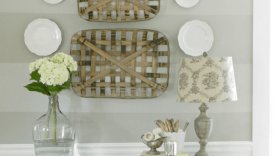Adding Sophistication: Filigree Floor Mirrors as Style Essentials

Definition of Filigree Floor Mirrors
When it comes to home decor, each piece of furniture serves not just a functional role, but also a creative one. Among these, filigree floor mirrors stand out as exquisite additions that combine artistry with practicality. But what exactly is a filigree floor mirror? A filigree floor mirror is a large, freestanding mirror distinguished by its intricately designed frame, which often features delicate, lace-like patterns. These patterns are usually made from metal, wood, or even synthetic materials, contributing to an elegant aesthetic that elevates any room. Imagine stepping into a space graced by a beautiful filigree mirror; the craftsmanship is undeniable, inviting admiration and enhancing the overall ambiance. Indeed, the term “filigree” originates from the Latin word “filum” which means wire, and “granum” meaning grain – a clear nod to the meticulous craftsmanship involved in creating these detailed designs. Key Characteristics of Filigree Floor Mirrors:
- Adding Sophistication: Filigree Floor Mirrors as Style Essentials
- Definition of Filigree Floor Mirrors
- History of Filigree Floor Mirrors
- Origins of Filigree Design
- Benefits of Filigree Floor Mirrors in Home Decor
- Enhancing Natural Light in a Space
- Types of Filigree Floor Mirrors
- Traditional Filigree Patterns
- How to Choose the Right Filigree Floor Mirror for Your Space
- Intricate Patterns: The hallmark of filigree design involves elaborate swirls and motifs, mimicking the elegance of lace.
- Material Variety: While traditional filigree mirrors often feature metal work, you can find modern interpretations made from wood, glass, or composite materials.
- Versatile Sizes: Ranging from tall, slender designs to wider, more robust shapes, filigree floor mirrors can complement any decor style.
Personal experiences with these mirrors reveal their transformative power. For instance, a friend recently incorporated a filigree floor mirror into her entryway. The result? A brighter, more inviting space that instantly caught the eye of any guest who stepped through the door. In essence, filigree floor mirrors are much more than reflective surfaces; they epitomize style, sophistication, and a hint of artistry that can breathe new life into your home. As we explore the history and benefits of these stunning mirrors, you’ll discover why they are becoming a must-have in contemporary decor.
History of Filigree Floor Mirrors
Origins of Filigree Design
The enchanting allure of filigree floor mirrors is deeply rooted in history, making them not just decorative items, but also vessels of cultural significance. To appreciate their beauty, it’s essential to understand the origins of filigree design itself. Historically, filigree work can be traced back to ancient civilizations, some of which include:
- Ancient Rome and Greece: Artisans utilized fine threads of gold and silver to create intricate jewelry and decorative items, laying the groundwork for the filigree technique.
- Middle Ages: The craft flourished with the arrival of the Gothic style, where lace-like metalworks adorned everything from religious relics to secular art.
- East Meets West: The Renaissance period saw a significant exchange of artistic styles between the East and West, resulting in unique filigree designs that incorporated Asian influences.
One personal anecdote involves exploring an antique shop during a trip through Europe. There, amidst historical relics, I stumbled upon an ornate filigree frame that belonged to a bygone era, showcasing the timeless skill and artistry of craftsmen. It was a moment that connected the past with the present, emphasizing the rich legacy behind these exquisite pieces. Key Contributions to Filigree Design:
- Materials Used: Traditional filigree was primarily crafted with precious metals, but modern iterations may use various materials, allowing for an array of designs and finishes.
- Cultural Fusion: As artisans adapted techniques from different cultures, the patterns evolved, providing a blend of creativity that resonates with diverse tastes.
- Technological Advances: With the advent of new tools and technologies, the precision and intricacy of filigree designs improved significantly, allowing for even more elaborate artistic expressions.
As filigree designs evolved over centuries, so too did their application. Today, filigree floor mirrors reflect not just a decorative flair but a storied history that connects generations, reminding us of the beauty in craftsmanship. Embracing these mirrors in contemporary homes means carrying forward a tradition that values artistry and elegance.
Benefits of Filigree Floor Mirrors in Home Decor
Enhancing Natural Light in a Space
In addition to their aesthetic charm, filigree floor mirrors have a remarkable ability to brighten up spaces by enhancing natural light. This benefit extends beyond mere reflection; it transforms the ambiance of a room, making it feel more open and inviting. A personal experience comes to mind when discussing this charming aspect. A friend of mine recently redecorated her living room and introduced a stunning filigree floor mirror near a window. The results were stunning! The sunlight streamed into the room each morning, bouncing off the intricate patterns of the mirror and creating a warm, inviting glow. It was as if the entire space had been energized, making it a delightful spot for gatherings and relaxation. Key Ways Filigree Floor Mirrors Enhance Light:
- Reflection Properties: The polished surface of a floor mirror captures and reflects sunlight, effectively doubling the amount of light that enters a room.
- Creating Illusion of Space: In smaller or darker areas, strategically placed mirrors can create the illusion of a more expansive space, making the room appear larger and airier.
- Artful Light Play: The ornate designs often found in filigree mirrors can scatter light in beautiful patterns across walls and floors, adding a dynamic element to the room.
Here are some tips for maximizing the light-enhancing properties of a filigree floor mirror:
- Placement Matters: Position your mirror near windows or in areas where it can catch direct sunlight.
- Complement with Lighter Colors: Surround your mirror with lighter shades of furniture and decor to further amplify the effect of natural light.
- Consider Mirror Size: Larger mirrors can have a more significant impact on light reflection and the feeling of space in a room.
Ultimately, incorporating a filigree floor mirror is not just about style; it’s about creating a luminous environment that uplifts the mood. With their ability to enhance natural light, these mirrors can truly transform a home, making it a brighter, more inviting sanctuary for all who enter.
Types of Filigree Floor Mirrors
Traditional Filigree Patterns
Delving into the enchanting world of filigree floor mirrors, one cannot overlook the beauty and intricacy of traditional filigree patterns. These designs have stood the test of time, reflecting the artistic heritage from which they originate. Traditional filigree designs feature elaborate, lace-like motifs crafted meticulously by skilled artisans. Each pattern tells a story, capturing the cultural essence and aesthetic values of the eras in which they were created. I vividly recall visiting a historic mansion during a local tour, where elegant filigree mirrors adorned the halls. The patterns varied from swirling vines to geometric designs, creating a dialogue between history and artistry. It was fascinating to learn that these mirrors not only served as functional art pieces but also as status symbols reflecting the wealth and taste of the homeowner. Common Traditional Filigree Patterns:
- Floral Motifs: Inspired by nature, floral designs incorporate delicate blossoms, leaves, and vines, adding a touch of softness and organic beauty.
- Geometric Shapes: These patterns often feature bold lines and shapes, lending a modern edge while echoing historical influences from various cultures.
- Scrollwork: The flowing, spiraled designs are classic elements in filigree art, embodying elegance and sophistication.
When considering traditional filigree patterns for home decor, it’s helpful to keep in mind a few pointers:
- Match Your Decor Style: Select patterns that harmonize with your existing decor, whether it’s rustic, contemporary, or vintage.
- Color Coordination: Many traditional filigree mirrors come in various finishes such as gold, silver, or bronze. Choose a finish that complements your color palette.
- Focus on Detail: The intricacy of the filigree design adds depth and character to a room; don’t hesitate to showcase it as a focal point.
Integrating a traditional filigree floor mirror is not just about enhancing the aesthetic appeal of a space; it’s about embracing and honoring a rich design legacy. Each mirror becomes a conversation starter—a beautiful artifact connecting the past with the present, augmenting the charm of any interior.
How to Choose the Right Filigree Floor Mirror for Your Space
Selecting the right filigree floor mirror for your home is an exciting journey that can enhance your decor while reflecting your personal style. With so many styles, sizes, and finishes available, making the right choice can feel overwhelming. However, by considering a few key factors, you can find the perfect mirror that suits your space beautifully. One of my closest friends recently revamped her hallway by incorporating a stunning filigree floor mirror, and the transformation was remarkable. She put careful thought into her selection process, which made a world of difference in achieving the inviting atmosphere she desired. Key Considerations When Choosing a Filigree Floor Mirror:
- Size Matters: Measure your available wall space and the dimensions of the area where you plan to place the mirror. A larger mirror can make a statement and create the illusion of a bigger space, while a smaller one can complement existing decor without overwhelming it.
- Style Integration: Think about your home’s overall decor style. Whether your home features modern minimalism, classic elegance, or boho charm, choose a filigree mirror that reflects that style. For instance, ornate designs with intricate detailing may be more suitable for traditional interiors, while cleaner lines may align with contemporary decor.
- Frame Finish: The finish of the mirror frame plays a crucial role in its aesthetic appeal. If your home features warm tones, a gold or bronze finish might be the perfect choice. Alternatively, silver or matte black finishes can impart a sleek, modern feel.
- Placement: Consider where the mirror will be placed. Positioning it near a window can enhance natural light, while a corner setup might enhance depth in a small room.
- Personal Touch: Finally, don’t forget to choose something that resonates with you. Whether it’s a specific pattern, color, or size, the best choice is one that makes you feel happy every time you see it.
In essence, selecting the right filigree floor mirror involves blending your personal style with functional considerations. By taking time to assess your needs and preferences, you’ll acquire a beautiful and purposeful addition to your decor that captures the essence of your space—much like my friend’s lovely hallway transformation.





